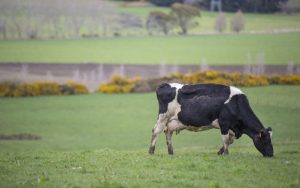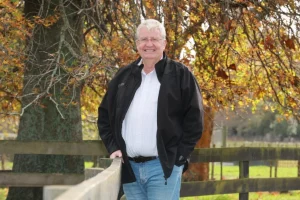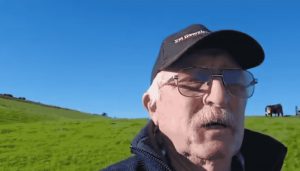
Sharon Coomey’s Facebook page doesn’t have a whole lot of content. Over five years there are perhaps a couple of dozen posts. Proud pictures of the grandchildren on the farm, Coomey looking glamorous at a family wedding, a photo gimmick from a cancer fundraiser, a selfie with husband Bill sticking his tongue out at the camera.
And then half way down there’s something totally different. A shot of a bank building and a 2017 Stuff article headlined “Interest rate swaps cause more headaches for ANZ as farmers sue for $7.5 million”.
And there you have the other side of Sharon and Bill Coomey. The tough, stubborn, righting-a-wrong side. The dairy farmers from Taranaki have for half a decade been fighting ANZ, New Zealand’s biggest bank. And they’ve been battling the $81 billion bank [its sharemarket capitalisation, not the $2b profit previously mentioned here and in the headline to this article] over a financial derivatives product so complicated that most of the bank managers selling it didn’t understand what could happen if things went wrong.
The court battle started in 2014, when the Coomeys, through their Bushline trustee companies, began proceedings in the High Court to recover up to $10 million of business losses and additional interest payments.
Their argument is complex. But it centres around what The National Bank (which was bought by ANZ in 2003, and merged into its operations in 2012) told the Coomeys about interest rate swaps.
Interest rate whats?
Swaps are enormously complicated and risky financial derivatives probably best dealt with in fast-paced international dealing rooms. Instead, New Zealand banks, including The National Bank, ASB and Westpac, sold these swaps to hundreds if not thousands of farming customers, particularly in the period up to the global financial crisis in 2008.
The trouble was that the banks’ assurances that these complex products were safe turned out to be false. And according to one estimate, up to 2000 New Zealand farmers may have lost close on $1 billion.
Why were farmers meddling in swaps anyway? Basically because at that time interest rates looked like they were going to keep rising for a while, meaning farmers who had borrowed money to expand their business were looking at potentially having to pay more and more interest on their loans. The answer: hedge the risk. Banks told farmers swaps were a great way to reduce the risk of having to pay more money on their bank debt.
Don’t worry, said the banks. Interest rate swaps seem complicated, but actually they are just like fixed rate loans, only with more flexibility and lower costs.
Anyway, we’ll see you right, the banks said. You can trust us.
And farmers, many of whom would have known their bank managers for years, played rugby with them, drunk beer with them, did trust them.
Only it didn’t work out that swaps were low risk and low cost. When the global financial crisis hit in 2008, interest rates fell fast and New Zealand farmers were left paying tens if not hundreds of millions of dollars more in interest rate payments than they would have done if they had stuck to standard fixed rate bank loans.
And the banks didn’t see them right. They dumped on them.
In good times and bad
In court, the Coomeys’ lawyer Murray Branch of Harkness Henry in Hamilton, argued ANZ/National Bank had reassured them the bank would be proactive in monitoring the interest rate risk so they wouldn’t lose out.
Branch said National Bank had told the Coomeys they could get out of the swaps if they needed to, and that the bank would be there for Bushline “in good times and bad”.
However when the global financial crisis turned the banking system to custard, and Bushline’s hitherto beneficial swaps became liabilities, the bank didn’t advise Sue and Bill Coomey to exit the swaps. And when they asked about getting out, the bank ignored them.
The margins on their borrowing soared.
No one seems to be arguing these days that what the National Bank told the Coomeys was “false and misleading”, nor that it was seriously detrimental to the farm finances.
What is up for debate is whether the ANZ should compensate them for their losses – and how much they should pay.
After a Commerce Commission investigation in 2013, ANZ offered the Coomeys a $155,000 settlement as part of a wider $18.5 million compensation payment to farmers.
They turned it down, arguing they were owed millions not $155,000. Instead they chose to take ANZ to court.
“I’m disgusted by what ANZ did”
Sharon and Bill Coomey didn’t want to talk to Newsroom for this story. Following the recent Court of Appeal ruling in their favour, they are in negotiations with their former bank and are worried about jeopardising those talks.
But other people want to tell their story. They say what the Coomeys have done with this case is astonishing, almost unbelievable.
They are very principled people. I really admire them for their guts and the shit they had to go through to get a win in court.
One of them is Valdimar Einarsson. Born in a tough rural community in Iceland – the sort of place “where you either survive or die” – Einarsson worked in rural banking in New Zealand for 20 years, before getting out of the industry. Now he often mediates between farmers, rural businesses and banks when there are problems.
He says he’s worked with the Coomeys for years.
“They are very principled people. I really admire them for their guts and the shit they had to go through to get a win in court. Standing up to a bank is really tough.”
Einarsson, “Valdi” to his friends, worked for Rabobank at the time.
“Rabobank asked me to look into selling [interest rate] swaps. I said we could do that, but we’d have to tell people about the downside.
“The best thing Rabobank did was not getting into swaps, but National Bank continued. I had conversations with National Bank and I said ‘You haven’t told people about the downside’. I said ‘You’ll end up with a whole load of betting slips no one is going to want to buy.’”
Which is just what happened. When interest rates went down instead of up, farmers were caught holding the equivalent of betting slips on losing horses.
As the Commerce Commission would find in its investigations, The National Bank/ANZ and to a lesser extent Westpac and ASB, protected their own interests, not those of their customers.
Einarsson reckons farmers lost between $800 million and $1 billion in the swaps fiasco. The Commerce Commission-ordered settlements with ANZ, Westpac and ASB provided less than $25 million in reparation.
He says there are plenty of former bankers who share his views on the interest rate swaps and who also left the industry.
“There were people I used to work with and I know they were just as disgusted by what ANZ did as I was. People that no longer wanted to do this for a living.”
“Deliberate misrepresentation”
Janette Walker is a former farmer who lost her 200-acre farm east of Palmerston North three years after the GFC and turned farmers’ advocate because she was angry at what the banks were doing to farmers. She was an unsuccessful Labour candidate for Kaikoura at the last election.
She says interest rate swaps were a disaster for farmers and wrecked people’s lives and livelihoods.
“It was a product that should never have been offered to farmers. It was deliberate misrepresentation.
“Working with farmers around swaps took three years of my life, yet even today there are aspects of swaps I don’t understand and I never will.”
And that’s not surprising. Last month’s Appeal Court judgment concludes ANZ Bank staff themselves didn’t recognise the downside of the products they were selling.
“In our view clearly there was considerable uncertainty and confusion within ANZ in 2008 and 2009 as to the true nature of the swap product it had been offering to rural clients since 2005,” Justices Forrest Miller, Raynor Asher and Denis Clifford wrote in their decision.
In particular, ANZ had been selling the swaps to farmers as being “just like fixed rate loans”, a claim which was totally wrong.
And by early 2009, ANZ knew that. It also knew that this misrepresentation was having a disastrous impact on farmers like the Coomeys.
Malcolm Nitschke, then ANZ’s senior rural manager for Hawera and Whanganui wrote to a colleague in January 2009 about the significant margin increases being imposed on ANZ clients at the time.
“The decision to fund bills on a 12-month term I consider was a ‘bank need’ and when combined with longer term swaps gave the impression to both clients and staff that the lending was for a much longer term. Once again the way these products were sold to the client by rural managers is questionable. (Hindsight is a great thing).
“Both our integrity and reputation are on the line.”
Part 1: “They get slaughtered”
November 2017 was a low point for Bill and Sue Coomey. After a hearing in the High Court at Auckland, Justice Rebecca Edwards ruled against the Coomeys. It wasn’t so much that she didn’t agree on what the bank had done, but she didn’t think ANZ had a duty of care to Bushline over any misrepresentation of the swaps. Nor had there been any promise by ANZ not to vary the 0.7 percent margin, she said.
There may have been verbal agreements, Edwards said, but Bill and Sharon Coomey had signed documents with clear disclaimers. Like this one:
“Each party agrees that it has not relied on any advice (whether oral or written) from the other party (other than set out in this confirmation) and that a) it has the capacity to evaluate the transaction and b) it understands and accepts the risks and obligations involved.”
And she accepted ANZ’s arguments that the Coomeys had been sent information as early as 2005 warning them that derivatives markets can be volatile and customers “may suffer substantial losses”.
Buyer beware.
‘You don’t go home until the cow is out of the ditch.’
Not only did the Coomeys lose the case in the High Court, but the judge awarded costs in favour of ANZ. She also increased them by 50 percent because, in her assessment, Bushline had acted unreasonably when it had declined two ANZ pre-trial settlement offers.
As Janette Walker says: “They got slaughtered.”
Most people advised the Coomeys to give up. Walker says the pressure involved in taking a case like this breaks marriages, wrecks lives. The suicide rate for farmers over the post-GFC period was graphic evidence of the stress people were going through, she says.
The Coomeys’ legal costs would have been more than six figures at this stage, she says, and there was no indication judges would accept their arguments in the end.
But farmers have a saying ‘You don’t go home until the cow is out of the ditch’, Walker says. The Coomeys chose to keep fighting.
“I congratulate them because they knew they were right. It was a point of principle for them. They believed what the banks were doing was wrong.
“They are people who believe in honesty and that your handshake is as good as your word. They are no fuss people, but they knew they were right and they were going to see it through.”
Part 2: The Appeal Court rules
Eighteen months later, on June 24 2019, the Coomeys got the vindication they had been looking for for five years. The three Appeal Court judges overturned the High Court ruling, and told ANZ it has to compensate the Coomeys – although the case has been thrown back to the High Court to decide how much money ANZ should pay.
In their judgement, Miller, Asher and Clifford put considerable weight on the Contractual Remedies Act, a 1979 statute which got merged into the Contract and Commercial Law Act in 2017. In particular the judges weighed whether ANZ should compensate Bushline for the various “false statements of fact” in their selling of the interest rate swaps.
The judgment found National Bank staff gave “false and misleading” information when they didn’t disclose the downsides of swap transactions compared to fixed rate loans. The judges found the Coomeys were right to think that their 0.7 percent margin had been fixed for longer than ANZ later claimed it had. And they said ANZ had given every impression to the Coomeys the bank would look out for them. That included giving them options around the best time to get out of (“break”) the swap contracts.
The judgment points to an exchange in court between the Coomeys’ lawyer Murray Branch and Stuart Esquilant, a former dealer in ANZ’s Global Markets team:
Branch: So the case for the plaintiff is that they thought you were giving them ongoing full advice and that would include at all time, options including pros and cons of breaking at a particular time. Do you accept that’s what you promised?
Esquilant: Yes.
B: You do accept without a question?
E: Yes. Yes, I do accept.
B: You accept that’s what you promised?
E: Yes.
But in court Esquilant said there was no evidence ANZ had “at any point through 2008” considered the potential for Bushline to break the swaps.
And although Bill Coomey contacted the bank in October 2008 to ask for an update on Bushline’s swaps strategies, including break costs, the bank’s advice “included several options for lengthening the swaps, with an associated interest rate saving. But there was no response to the request for break costs,” the judgment says.
“The first time a break cost calculation was provided to the Coomeys in terms of the documentary record was in February 2009, at which point the break costs were in the vicinity of $1.6 million.”
The judgment emphasises the imbalance of bargaining power between the bank and the Coomeys, and the fact that all the information about swaps given to the farming couple, their lawyer and accountants all came from the same source – ANZ presentations.
The Appeal Court judges were unequivocal in their slating of ANZ’s tactics.
“We do not think it fair and reasonable that ANZ should be able in effect to say to the Coomeys: ‘Notwithstanding what we promised we would do and what we represented to be true, you have no claim against us even though we did not do what we said we would and what we represented to you was false.’”
Swaps: “a legitimate product for farmers”
ANZ spokesman Stefan Herrick says the bank is disappointed with the Court of Appeal decision and hasn’t decided whether to take the case to the Supreme Court. The bank can’t discuss any negotiations with the Coomeys or any sums they may have been offered in the past, Herrick says.
He says sales practices around derivatives have been “extensively reviewed and changed” since 2008, and he defends the bank’s right to sell swaps to farmers.
“Interest rate swaps are a legitimate product for farmers and others wishing to manage their interest rate exposures.
“Before signing up to a transaction we make sure customers sign appropriate documentation to acknowledge they understand the product and we recommend in writing that they seek appropriate external advice.”
Certainly there’s an argument this is just one more piece of evidence that banks don’t always follow the rules.
ANZ, the country’s biggest bank with profits of almost $2 billion last year, is particularly in the firing line at the moment. The Reserve Bank has censured ANZ over its capital requirement modelling, and is asking for two reports about its financial prudence. At the same time the bank is embroiled in an expenses scandal involving its former chief executive David Hisco and his wife, with some people calling for the head of the chair of the bank, former Prime Minister Sir John Key.
In the past, ANZ has had to pay compensation to customers over errors around KiwiSaver and home loan payments. It’s one of the banks in trouble over sales incentives. And it’s even found itself involved in the scandal around Israel Folau’s homophobic social media posts. His wife Maria is a star Silver Ferns netball player and ANZ sponsors her employer, Netball New Zealand.
Wider implications
Farm consultant Valdimar Einarsson says in an environment where New Zealand banks are under huge pressure from government, regulators and customers about their behaviour, this case has implications far beyond interest rate swaps.
“This judgment is a lot bigger than the Coomeys and they realise that. Consumers and farmers need protection through legislation when it comes to banks.
“This tells me there is legislation [the Contractual Remedies Act provisions, now embedded in the Contract and Commercial Law Act]. Why haven’t they been pulled up before?”
He says the problems in the ANZ vs Bushline case may appear to be historic, but he says there are multiple and ongoing problems between farmers and banks because the banks still have all the power.
“I see it every day, mostly in terms of the margins they charge, the costs, how they intimidate people, and the lack of requirement to have to refer to the law.”
Einarsson says the Farm Debt Mediation Bill going through Parliament at the moment is a step forward, but isn’t enough.
“The rural sector has put up with this for years. We need laws that protect us. We need to look at existing legislation and pull it together and make it more specific to bankers.”
Einarsson says the Coomey-ANZ judgment is also important because until now there has been a shortage of case law involving banks misrepresenting products to their customers. Going to court is expensive and uncertain and disputes tend to be sorted at the last minute, he says.
“Banks will settle. They try to finish customers off before they can go to court.”























